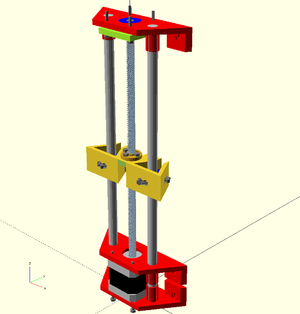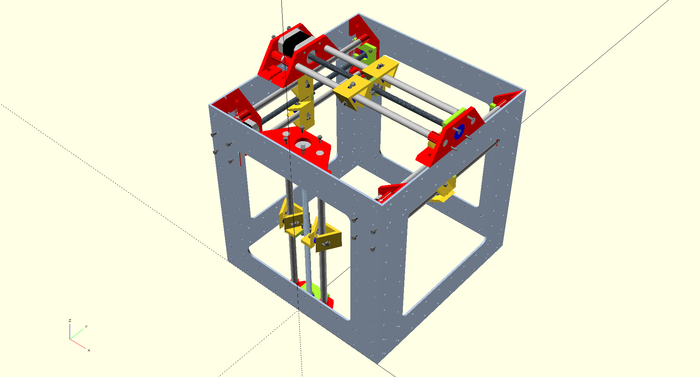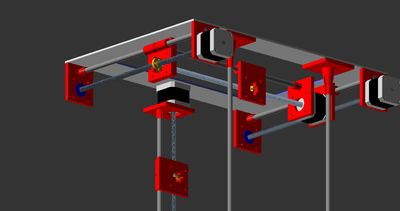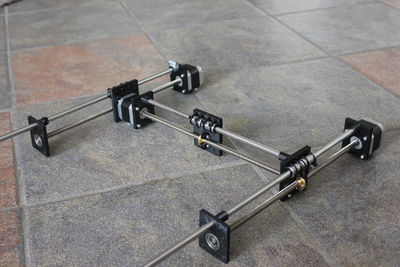D3D Printer Design Process
This document lists D3D Printer Design decisions and reasoning behind them in chronological order. The intention is to make the process as debuggable as possible and facilitate later creation of formal documents such as Design Decision Tree and Conceptual Design diagrams. It follows the D3D_Design_Methodology.
Sources Driving Design Desicions in Priority Order
- D3D_Fusion_printer_design#Higher_Level_Goals
- D3D_Fusion_printer_design#Desired_Attributes
- D3D_Fusion_printer_design#Functional_Requirements
- RepRap Interface Standard
- The shape of the input determines the shape of the design and tests.[1]
Process
Concept Creation Linear Actuator Modules
NOTE: We started out this process with concept creation. This deviates from the D3D Design Methodology, but we document it here nontheless.
D3D_Printer_Design#Functional_Requirement nr 1 is that the printer should be buildable in one day, and a parallelizable build is highly desired. A random Youtube search around modularity in CNC machines led to discovering the concept of modular linear actuators, as shown by Alexander Stepanenko in a video. These kind of actuators are sometimes called "linear stages" and are sold as ready-built units[1][2]. The concept would allow
- ... building linear actuators and other parts at the same time
- ... defining a ubiquitous standard (screw position) interface
Normally, we would reason here around advantages that the concept of modular linear actuators could provide, but OSE found its potential exciting enough to put it directly into D3D_Printer_Design#Functional_Requirements.
Instead of diving into stepwise definition of interface and linear actuator, we decided to grab the following low-hanging fruit:
- Standard Screw Interface: Nema17
- Linear Actuator: Stepper Motor + lead screw
Why Not...
| ... ball screw? | Price. See [3] |
| ... threaded rod? | Speed and straightness. See [4] |
| ... threadless ball screw? | Kind of hard to put together and risks slipping. See [5] |
Verification Steps Taken for Lead Screw + Stepper Motor Concept
CAD viability
Looks sane...
Practical viability of lead screws for 3D printing loads and speeds
| Link | Comment |
|---|---|
| https://www.youtube.com/watch?v=gk9lhcTGSH4 | Printing at 75mm/s (fast) with aggressive leadscrew. Lots of rattling from linear bearings. Sub-optimal construction with lead screw not between smooth rods may be cause. 2014. |
| https://www.youtube.com/watch?v=reVNrtsDfxQ | Slow first layer, normal RepRap speed after that. Uses cheap 8/8 mm lead screws. Every time acceleration changes direction, you hear a "bump". Two flanged nuts with a spring between them would fix this. 2015. |
| https://www.youtube.com/watch?v=wWZqLwwwx_k | Printer is called Fina. Leadscrews are 6-start. 18 mm travel/rev. 12 mm diameter |
| https://www.youtube.com/watch?v=ULVLZpHSlzc | Trinitylabs' printer, Aluminatus. They went out of business in May 2014. |
| https://www.youtube.com/watch?v=4bMUlu4GF2k | Trinitylabs again, with Aluminatus printing faster |
| http://www.igus.no/wpck/12976/Manus15_3D_printer_3 | In this link, Igus shows off some of their products in a all-leadscrew 3D printer |
| http://www.igus.eu/wpck/10783/3Dprinting | Here Igus shows off more 3D printer applications (under "Application examples") |
| this advertisment and [6] | ... shows that 3D printer applications seems to be a common idea among lead screw suppliers |
Vermont Rapid Prototyping's Jon in mail: "I have been using my Aluminatus heavily for the 2 years or so that I've had it, and it continues to perform very well. I like the linear bearings and lead screws a lot."
Theoretical force viability
Newtons second law:
F = ma
Total linear actuator weight is approximated like
| Parameter | Estimated value | Unit | Source |
|---|---|---|---|
| Motor: | 0.4 | kg | stepper motor shop |
| Lead screw/Smooth rod: | 0.12 | kg | density=8000 kg/m^3, radius=4 mm and length=300 mm |
| Linear Bearing | 0.015 | kg | linear bearing shop |
| Hot End | 0.05 | kg | hot end shop |
| X-Carriage (extruder + hot end): | 0.67 | kg | Hotend + Motor + Four linear bearings + 0.05 kg of plastic + 20 percent |
| Linear Actuator Module: | 0.81 | kg | Motor + two smooth rods + lead screw + 0.05 kg of plastic |
| Y-Carriage (X-Carriage + linear actuator module): | 1.48 | kg | Linear Actuator Module + X-Carriage |
The linear actuator will have to meet following circa-requirements to be realistic:
| Parameter | Value | Unit | Source |
|---|---|---|---|
| Weight load: | 0.74 | kg | Y-Carriage weight/2 |
| Max Speed: | 0.070 | m/s | Stepper Motor generally don't want to run faster than 300 rev/min. Lead screws that are more aggressive than 14-15 mm per revolution are hard to source. |
| Max acceleration: | 5 | m/s^2 | Requirements/choice |
| Worst expected Lead screw efficiency: | 60 | % | CNC router source, Youtube video showing lead screw is back drivable. Implies > 50 % efficiency[7]. |
Torque from rotational inertia is not included in the table because inertia of the threaded rod is tiny (order of 10^-7 kg m^2). Newton's second law gives maximum force needed:
F = (0.74 * 5)/0.6 = 6.16 N
The lever length of is ~3.5 mm, so torque on stepper motor is 0.022 Nm = 2.2 Ncm.
Let's do some more pessimistic assumptions: lead screw efficiency at 20 %, skewed weight distribution of Y-axis gives double max weight: 1.3 kg. Accelerations of 9 m/s^2. This gives a force of 58.5 N and a torque of 20.5 Ncm, which is still within stepper motor limits at max speed (70 mm/s) for three of the four tested Nema17 stepper motor models tested here.
We conclude that a linear actuator based on a lead screw and a Nema17 stepper motor seems realizable.
Suggested Tests For Further Validation
- A custom gcode generating random movements like shown in this video.
- Stepping through Oriantal Motors' Sizing Calculations.
- Verify stepper motor performance like is done here: http://www.romanblack.com/stepper.htm
Leadscrew sourcing viability
Some lead screws are already mounted on stepper motors[8][9]. This improves ease of build. Most of them are 8mm diameter with 8mm travel per revoultion. This would lead to challenges as it forces stepper motors into > 300 rev/min-land.
Good 8mm diameter 15mm travel lead screws can be sourced at http://www.mooreinternational.co.uk/category-31.html. Look for Speedy - Standard, 8/15.
Sources kindly shared by RepRap forums user albatroopa:
| Item | Part Number | Source | Price | |
|---|---|---|---|---|
| 3/8-8 4:1 leadscrew (3ft) | 99030A303 | Mcmaster | $28.53 | |
| 3/8-8 4:1 nut (Bronze) | 1343K111 | Mcmaster | $32.41 | |
| 3/8 bearings (flanged) | 6384K344 | Mcmaster | $6.49 |
Smooth Rod Sourcing
Problem with Forces Along Lead Screw
Some suggest cheap deep groove bearings are ok. Other say angular contact bearings are what we want.
Possibilities of Unknown Importance
Could we send bed probe signal through Z-leadscrew? Would avoid a wire and improve scalability.
Previous Implementations
The idea to use lead screws to make 3D printers easier to understand will not be unique to the D3D Printer. A company sell all-leadscrew drivem 3D-printers with the slogan "3D schreiber begreifen": [10]
Concept Creation Incomplete Frame
The basic idea is that we can base all alignment on one single frame piece:
The concept doesn't handle gravity forces, but mounting along a wall, in strings or rubber bands from ceiling or below any four-legged table should be possible.
Stepper motors with leadscrew shafts of 8mm travel per revoultion was thrown together (on April 12, 2016) to test the concept:
Stepwise Definition of 3D Printer
3D Printer Signature
Input: Power, Build material, Supporting surface(s), Instructions Output: Physical object
3D Printer Purpose Statement
A 3D printer is a machine that synthesizes build material into 3D objects according to a series of pre-determined instructions.
3D Printer Examples
We will assume that a mains voltage will power the 3D printer, with the constant shape:
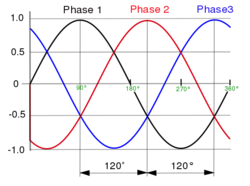
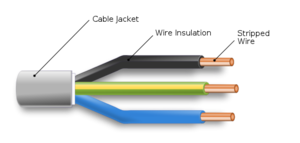
For the build material, we will assume filaments behaving roughly as thermoplastics with the constant shape: ...
References
- ↑ 1.0 1.1 FELLEISEN, Matthias. How to Design Programs: an introduction to programming and computing. MIT Press, 2001.
